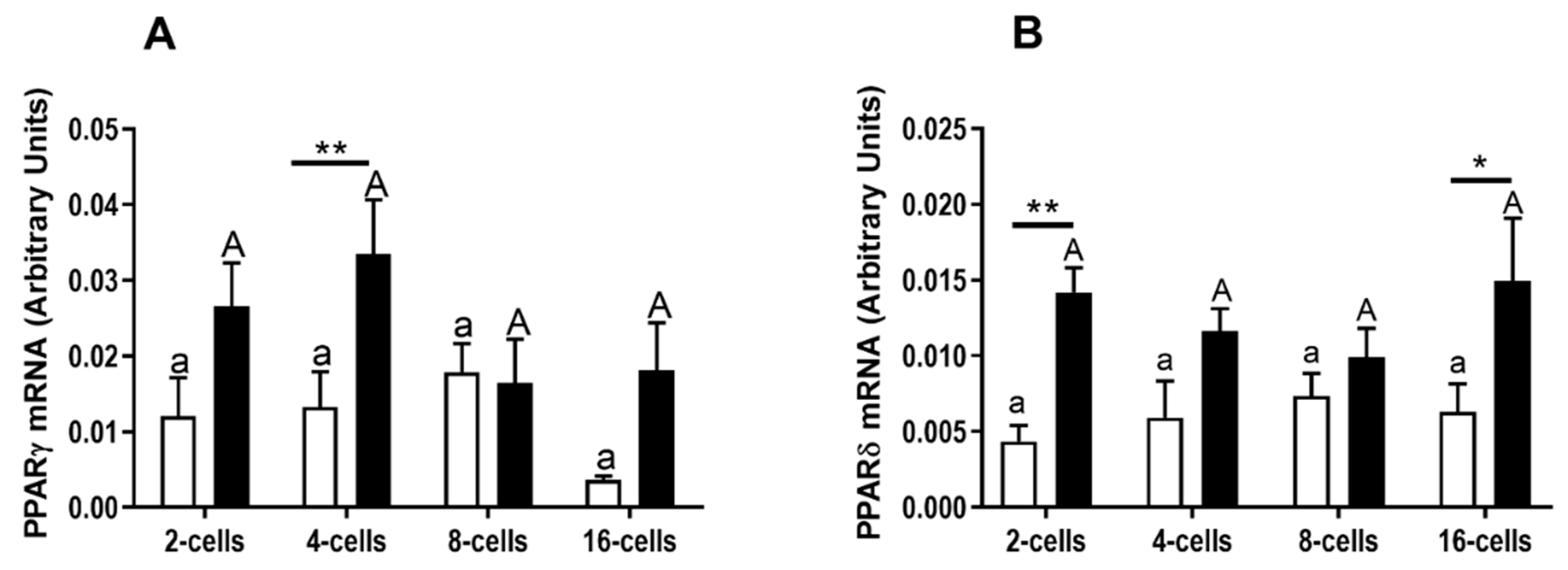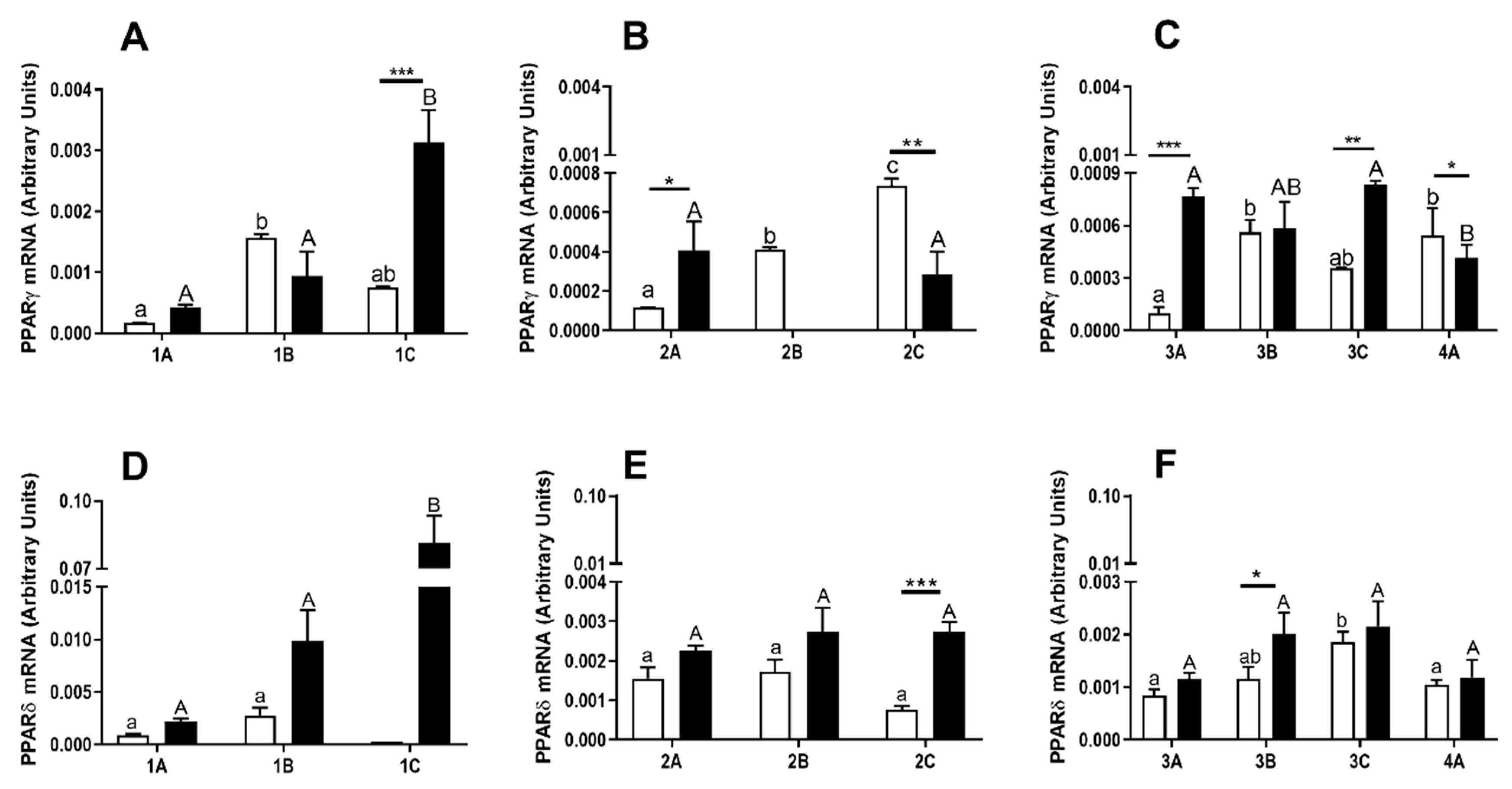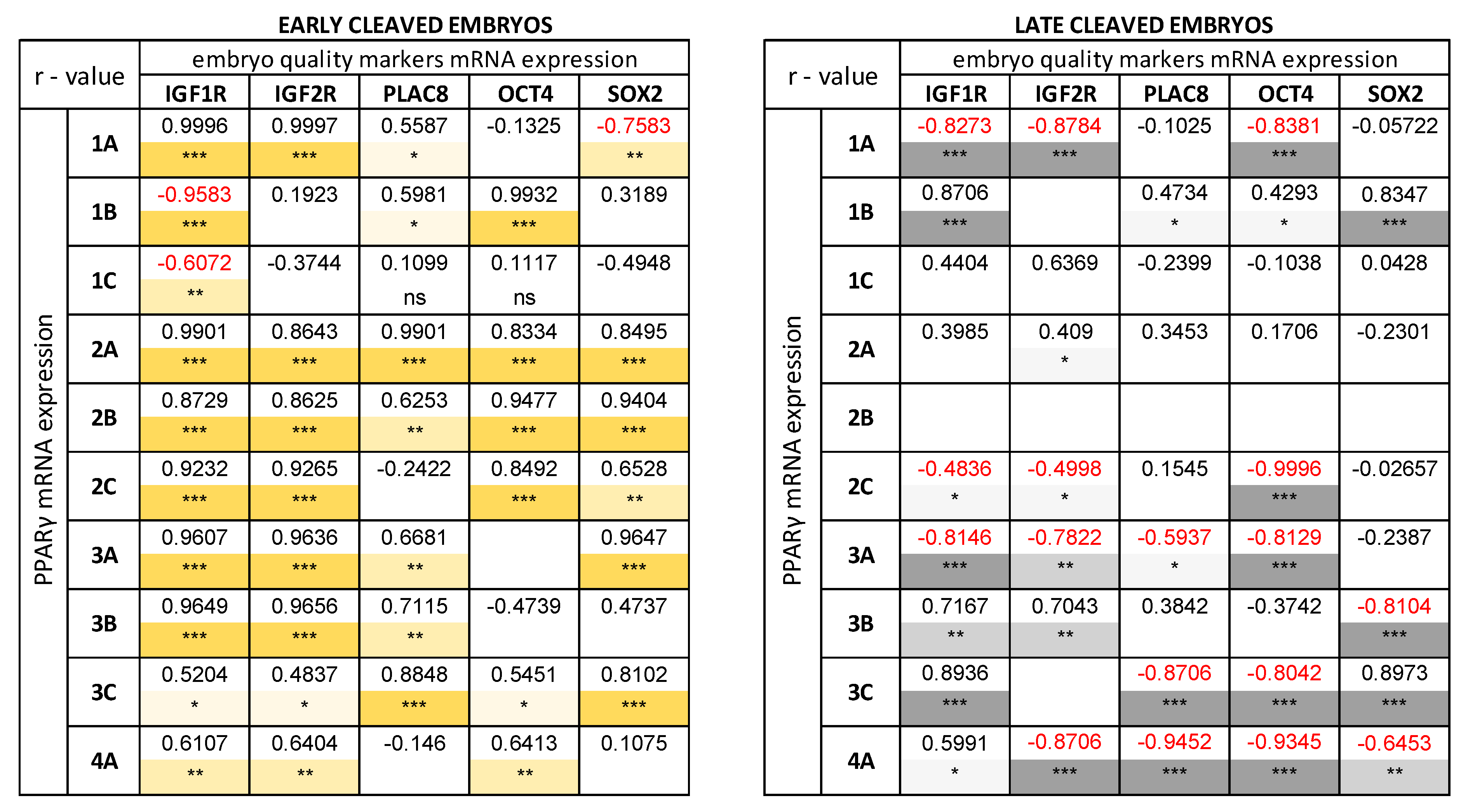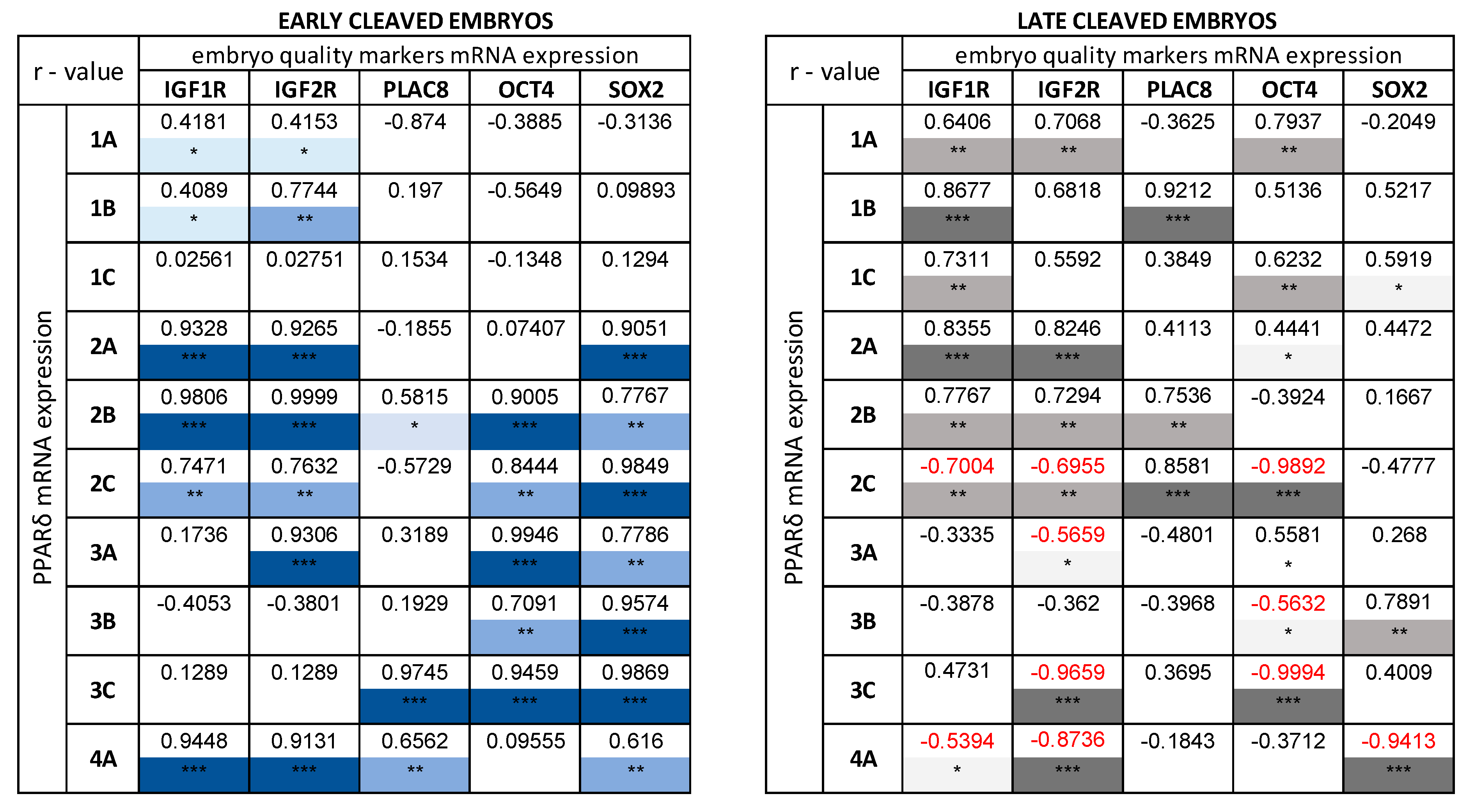mRNA Expression and Role of PPARγ and PPARδ in Bovine Preimplantation Embryos Depending on the Quality and Developmental Stage
Abstract
Simple Summary
Abstract
1. Introduction
2. Materials and Methods
2.1. Cumulus-oocyte Complexes (COCs) Collection
2.2. In Vitro Maturation
2.3. Semen Capacitation
2.4. In Vitro Fertilization
2.5. In Vitro Embryo Culture
2.6. Total RNA Extraction, Reverse Transcription (RT) and Real-Time PCR
2.7. Statistical Analysis
3. Results
3.1. The Expression of PPARγ and PPARδ in the Bovine Embryo at the Early Stages of Development
3.2. Expression of PPARγ and PPARδ in the Bovine Morulaes
3.3. The Expression of PPARγ and PPARδ in the Bovine Blastocysts
3.4. Correlation between mRNA Expression of PPARγ, PPARδ and Embryo Quality Markers (IGF1R, IGF2R, PLAC8, OCT4, SOX2) in the Bovine Blastocysts
4. Discussion
5. Conclusions
Supplementary Materials
Author Contributions
Funding
Acknowledgments
Conflicts of Interest
References
- Loftin, C.D.; Tiano, H.F.; Langenbach, R. Phenotypes of the COX-deficient mice indicate physiological and pathophysiological roles for COX-1 and COX-2. Prostaglandins Other Lipid Mediat. 2002, 68–69, 177–185. [Google Scholar] [CrossRef]
- Matsumoto, H.; Ma, W.; Smalley, W.; Trzaskos, J.; Breyer, R.M.; Dey, S.K. Diversification of cyclooxygenase-2-derived prostaglandins in ovulation and implantation. Biol. Reprod. 2001, 64, 1557–1565. [Google Scholar] [CrossRef] [PubMed]
- Huang, J.C.; Wun, W.S.; Goldsby, J.S.; Wun, I.C.; Falconi, S.M.; Wu, K.K. Prostacyclin enhances embryo hatching but not sperm motility. Hum. Reprod. 2003, 18, 2582–2589. [Google Scholar] [CrossRef] [PubMed][Green Version]
- Huang, J.C.; Wun, W.S.; Goldsby, J.S.; Matijevic-Aleksic, N.; Wu, K.K. Cyklooxygenase-2-derived endogenous prostacyclin enhances mouse embryo hatching. Hum. Reprod. 2004, 19, 2900–2906. [Google Scholar] [CrossRef]
- Pakrasi, P.L.; Jain, A.K. Cyclooxygenase-2-derived endogenous prostacyclin reduces apoptosis and enhances embryo viability in mouse. Prostaglandins Leukot Essent Fatty Acids 2008, 79, 27–33. [Google Scholar] [CrossRef]
- Huang, J.C.; Wun, W.S.; Goldsby, J.S.; Egan, K.; FitzGerald, G.A.; Wu, K.K. Prostacyclin receptor signaling and early embryo development in the mouse. Hum. Reprod. 2007, 22, 2851–2856. [Google Scholar] [CrossRef][Green Version]
- Barak, Y.; Nelson, M.C.; Ong, E.S.; Jones, Y.Z.; Ruiz-Lozano, P.; Chien, K.R.; Koder, A.; Evans, R.M. PPARγ is required for placental, cardiac, and adipose tissue development. Mol. Cell 1999, 4, 585–595. [Google Scholar] [CrossRef]
- Mohan, M.; Malayer, J.R.; Geisert, R.D.; Morgan, G.L. Expression Patterns of Retinoid X Receptors, Retinaldehyde Dehydrogenase, and Peroxisome Proliferator Activated Receptor Gamma in Bovine Preattachment Embryos. Biol. Reprod. 2002, 66, 692–700. [Google Scholar] [CrossRef]
- Narumiya, S.; Sugimoto, Y.; Ushikubi, F. Prostanoid Receptors: Structures, Properties, and Functions. Physiol. Rev. 1999, 79, 1193–1226. [Google Scholar] [CrossRef]
- Chen, L.; Yang, G.; Grosser, T. Prostanoids and inflammatory pain. Prostaglandins Other Lipid Mediat. 2013, 104–105, 58–66. [Google Scholar] [CrossRef]
- Halliwell, R.J.; Berry, E.B.; O’Carroll, S.J.; Mitchell, M.D. Nuclear prostaglandin receptors: Role in pregnancy and parturition? Prostaglandins Leukot Essent Fatty Acids 2004, 70, 149–165. [Google Scholar] [CrossRef] [PubMed]
- Namba, T.; Oida, H.; Sugimoto, Y.; Kakizuka, A.; Negishi, M.; Ichikawa, A.; Narumiya, S. cDNA cloning of a mouse prostacyclin receptor. Multiple signaling pathways and expression in thymic medulla. J. Biol. Chem. 1994, 269, 9986–9992. [Google Scholar]
- Barak, Y.; Sadovsky, Y.; Shalom-Barak, T. PPAR Signaling in Placental Development and Function. PPAR Res. 2008, 2008, 142082. [Google Scholar] [CrossRef] [PubMed]
- Liou, J.Y.; Lee, S.; Ghelani, D.; Matijevic-Aleksic, N.; Wu, K.K. Protection of endothelial survival by peroxisome proliferator-activated receptor-delta mediated 14-3-3 upregulation. Arterioscler. Thromb. Vasc. Biol. 2006, 26, 1481–1487. [Google Scholar] [CrossRef] [PubMed]
- Boiani, M.; Eckardt, S.; Schöler, H.R.; McLaughlin, K.J. Oct4 distribution and level in mouse clones: Consequences for pluripotency. Gene Dev. 2002, 16, 1209–1219. [Google Scholar] [CrossRef] [PubMed]
- Keramari, M.; Razavi, J.; Ingman, K.A.; Patsch, C.; Edenhofer, F.; Ward, C.M.; Kimber, S.J. Sox2 is essential for formation of trophectoderm in the preimplantation embryo. PLoS ONE 2010, 5, 139–152. [Google Scholar] [CrossRef]
- Matsui, M.; Takahashi, Y.; Hishinuma, M.; Kanagawa, H. Stimulation of the development of bovine embryos by insulin and insulin-like growth factor-I (IGF-I) is mediated through the IGF-I receptor. Theriogenology 1997, 48, 605–616. [Google Scholar] [CrossRef]
- Liu, H.C.; He, Z.Y.; Mele, C.A.; Veeck, L.L.; Davis, O.K.; Rosenwaks, Z. Expression of IGFs and their receptors is a potential marker for embryo quality. Am. J. Reprod. Immunol. 1997, 38, 237–245. [Google Scholar] [CrossRef]
- Rekik, W.; Dufort, I.; Sirard, M.A. Analysis of the gene expression pattern of bovine blastocysts at three stages of development. Mol. Reprod. Dev. 2011, 78, 226–240. [Google Scholar] [CrossRef]
- Lonergan, P.; Khatir, H.; Piumi, F.; Rieger, D.; Humblot, P.; Boland, M.P. Effect of time interval from insemination to first cleavage on the developmental characteristics, sex ratio and pregnancy rate after transfer of bovine embryos. J. Reprod. Fertil. 1999, 117, 159–167. [Google Scholar] [CrossRef]
- Patel, O.V.; Bettegowda, A.; Ireland, J.J.; Coussens, P.M.; Lonergan, P.; Smith, G.W. Functional genomics studies of oocyte competence: Evidence that reduced transcript abundance for follistatin is associated with poor developmental competence of bovine oocytes. Reproduction 2007, 133, 95–106. [Google Scholar] [CrossRef]
- Lechniak, D.; Pers-Kamczyc, E.; Pawlak, P. Timing of the first zygotic cleavage as a marker of developmental potential of mammalian embryos. Reprod. Biol. 2008, 8, 23–42. [Google Scholar] [CrossRef]
- Jensen, J.; Orntoft, T. Normalization of real-time quantative PCR data: A model based variance estimation approach to identify genes suited for normalization–applied to bladder- and colon-cancer data-sets. Cancer Res. 2004, 64, 5245–5250. [Google Scholar]
- Primer3 Input (Version 0.4.0). Available online: https://bioinfo.ut.ee/primer3-0.4.0/primer3/input.htm (accessed on 23 April 2019).
- Real-time PCR Miner. Available online: http://miner.ewindup.info (accessed on 23 April 2019).
- Braissant, O.; Wahli, W. Differential expression of peroxisome proliferator-activated receptor-alpha, -beta, and -gamma during rat embryonic development. Endocrinology 1998, 139, 2748–2754. [Google Scholar] [CrossRef]
- Desmarais, J.A.; Lopes, F.L.; Zhang, H.; Das, S.K.; Murphy, B.D. The peroxisome proliferator-activated receptor gamma regulates trophoblast cell differentiation in mink (Mustela vison). Biol. Reprod. 2007, 77, 829–839. [Google Scholar] [CrossRef] [PubMed]
- Brooks, K.E.; Burn, G.W.; Spencer, T.E. Peroxisome proliferator activator receptor gamma (PPAG) regulates conceptus elongation in sheep. Biol. Reprod. 2015, 92, 42. [Google Scholar] [CrossRef] [PubMed]
- Escher, P.; Braissant, O.; Basu-Modak, S.; Michalik, L.; Wahli, W.; Desvergne, B. Rat PPARs: Quantitative analysis in adult rat tissues and regulation in fasting and refeeding. Endocrinology 2001, 142, 4195–4202. [Google Scholar] [CrossRef]
- Kang, H.J.; Hwang, S.J.; Yoon, J.A.; Jun, J.H.; Lim, H.J.; Yoon, T.K.; Song, H. Activation of peroxisome proliferators-activated receptor δ (PPARδ) promotes blastocyst hatching in mice. Mol. Hum. Reprod. 2011, 17, 653–660. [Google Scholar] [CrossRef]
- Guo, J.; Lu, W.F.; Liang, S.; Choi, J.W.; Kim, N.H.; Cui, X.S. Peroxisome proliferator-activated receptor δ improves porcine blastocyst hatching via the regulation of fatty acid oxidation. Theriogenology 2017, 90, 266–275. [Google Scholar] [CrossRef]
- Cammas, L.; Reinaud, P.; Bordas, N.; Dubois, O.; Germain, G.; Charpigny, G. Developmental regulation of prostacyclin synthase and prostacyclin receptors in the ovine uterus and conceptus during the peri-implantation period. Reproduction 2006, 131, 917–927. [Google Scholar] [CrossRef]
- Roberti, S.L.; Higa, R.; White, V.; Powell, T.L.; Jansson, T.; Jawerbaum, A. Critical role of mTOR, PPARγ and PPARδ signaling in regulating early pregnancy decidual function, embryo viability and feto-placental growth. Mol. Hum. Reprod. 2018, 24, 327–340. [Google Scholar] [CrossRef] [PubMed]
- Sapin, V.; Dollé, P.; Hindelang, C.; Kastner, P.; Chambon, P. Defects of the chorioallantoic placenta in mouse RXRalpha null fetuses. Dev. Biol. 1997, 191, 29–41. [Google Scholar] [CrossRef] [PubMed]
- Abdelalim, E.M.; Emara, M.M.; Kolatkar, P.R. The SOX transcription factors as key players in pluripotent stem cells. Stem Cells Dev. 2014, 23, 2687–2699. [Google Scholar] [CrossRef] [PubMed]
- Goissis, M.D.; Cibelli, J.B. Functional characterization of SOX2 in bovine preimplantation embryos. Biol. Reprod. 2014, 90, 30. [Google Scholar] [CrossRef]
- Khan, D.R.; Dubé, D.; Gall, L.; Peynot, N.; Ruffini, S.; Laffont, L.; Le Bourhis, D.; Degrelle, S.; Jouneau, A.; Duranthon, V. Expression of pluripotency master regulators during two key developmental transitions: EGA and early lineage specification in the bovine embryo. PLoS ONE 2012, 7, e34110. [Google Scholar] [CrossRef]
- Foygel, K.; Choi, B.; Jun, S.; Leong, D.E.; Lee, A.; Wong, C.C.; Zuo, E.; Eckart, M.; Pera, R.A.; Wong, W.H.; et al. A novel and critical role for Oct4 as a regulator of the maternal-embryonic transition. PLoS ONE 2008, 3, e4109. [Google Scholar] [CrossRef]
- Gendelman, M.; Aroyo, A.; Yavin, S.; Roth, Z. Seasonal effects on gene expression, cleavage timing, and developmental competence of bovine preimplantation embryos. Reproduction 2010, 140, 73–82. [Google Scholar] [CrossRef]
- Gendelman, M.; Roth, Z. In vivo vs. in vitro models for studying the effects of elevated temperature on the GV stage oocyte, subsequent developmental competence and gene expression. Anim. Reprod. Sci. 2012, 134, 125–134. [Google Scholar] [CrossRef]
- Wang, L.M.; Feng, H.L.; Ma, Y.Z.; Cang, M.; Li, H.J.; Yan, Z.; Zhou, P.; Wen, J.X.; Bou, S.; Liu, D.J. Expression of IGF receptors and its ligands in bovine oocytes and preimplantation embryos. Anim. Reprod. Sci. 2009, 114, 99–108. [Google Scholar] [CrossRef]
- Yaseen, M.A.; Wrenzycki, C.; Herrmann, D.; Carnwath, J.W.; Niemann, H. Changes in the relative abundance of mRNA transcripts for insulin-like growth factor (IGF-I and IGF-II) ligands and their receptors (IGF-IR/IGF-IIR) in preimplantation bovine embryos derived from different in vitro systems. Reproduction 2001, 122, 601–610. [Google Scholar] [CrossRef]
- El-Sayed, A.; Hoelker, M.; Rings, F.; Salilew, D.; Jennen, D.; Tholen, E.; Sirard, M.A.; Schellander, K.; Tesfaye, D. Large-scale transcriptional analysis of bovine embryo biopsies in relation to pregnancy success after transfer to recipients. Physiol. Genom. 2006, 28, 84–96. [Google Scholar] [CrossRef] [PubMed]
- Ghanem, N.; Salilew-Wondim, D.; Gad, A.; Tesfaye, D.; Phatsara, C.; Tholen, E.; Looft, C.; Schellander, K.; Hoelker, M. Bovine blastocysts with developmental competence to term share similar expression of developmentally important genes although derived from different culture environments. Reproduction 2011, 142, 551–564. [Google Scholar] [CrossRef] [PubMed]





| Gene | Gene Bank ID | Primer Sequences (3′-5′) | Amplicon Size (bp) |
|---|---|---|---|
| PPARγ | NC_037349.1 | F: AGTGGAGACCGCCCAGGTTTGR: GGGAGGACTCGGGGTGGTTC | 104 |
| PPARδ | NM_001083636.1 | F: TGCGGGGCTTCTCCCATGACR: AGCCGTGAGTCCTGCCAAGT | 81 |
| OCT4 | NM_174580.2 | F: GAGAAAGACGTGGTCCGAGTGR: GACCCAGCAGCCTCAAAATC | 101 |
| SOX2 | NM_001105463.2 | F: TGGATCGGCCAGAAGAGGAGR: CAGGCGAAGAATAATTTGGGGG | 89 |
| PLAC8 | NM_001025325.2 | F: TTTACCGCTCTGTGCCCTTTR: CCATGTGAACTTGACCAAGCAT | 95 |
| IGF1R | NM_001244612.1 | F: GAGTGGAGAAATCTGCGGGR: AAATGAGCAGGATGTGGAGGT | 110 |
| IGF2R | NM_174352.2 | F: ACCTCCGATCCTCAATCCCAR: TGTAGTTGAAGTGCCGGTCC | 82 |
| GAPDH | NM_001034034.2 | F: CACCCTCAAGATTGTCAGCAR: GGTCATAAGTCCCTCCACGA | 103 |
Publisher’s Note: MDPI stays neutral with regard to jurisdictional claims in published maps and institutional affiliations. |
© 2020 by the authors. Licensee MDPI, Basel, Switzerland. This article is an open access article distributed under the terms and conditions of the Creative Commons Attribution (CC BY) license (http://creativecommons.org/licenses/by/4.0/).
Share and Cite
Suwik, K.; Sinderewicz, E.; Boruszewska, D.; Kowalczyk-Zięba, I.; Staszkiewicz-Chodor, J.; Łukaszuk, K.; Wocławek-Potocka, I. mRNA Expression and Role of PPARγ and PPARδ in Bovine Preimplantation Embryos Depending on the Quality and Developmental Stage. Animals 2020, 10, 2358. https://doi.org/10.3390/ani10122358
Suwik K, Sinderewicz E, Boruszewska D, Kowalczyk-Zięba I, Staszkiewicz-Chodor J, Łukaszuk K, Wocławek-Potocka I. mRNA Expression and Role of PPARγ and PPARδ in Bovine Preimplantation Embryos Depending on the Quality and Developmental Stage. Animals. 2020; 10(12):2358. https://doi.org/10.3390/ani10122358
Chicago/Turabian StyleSuwik, Katarzyna, Emilia Sinderewicz, Dorota Boruszewska, Ilona Kowalczyk-Zięba, Joanna Staszkiewicz-Chodor, Krzysztof Łukaszuk, and Izabela Wocławek-Potocka. 2020. "mRNA Expression and Role of PPARγ and PPARδ in Bovine Preimplantation Embryos Depending on the Quality and Developmental Stage" Animals 10, no. 12: 2358. https://doi.org/10.3390/ani10122358
APA StyleSuwik, K., Sinderewicz, E., Boruszewska, D., Kowalczyk-Zięba, I., Staszkiewicz-Chodor, J., Łukaszuk, K., & Wocławek-Potocka, I. (2020). mRNA Expression and Role of PPARγ and PPARδ in Bovine Preimplantation Embryos Depending on the Quality and Developmental Stage. Animals, 10(12), 2358. https://doi.org/10.3390/ani10122358





